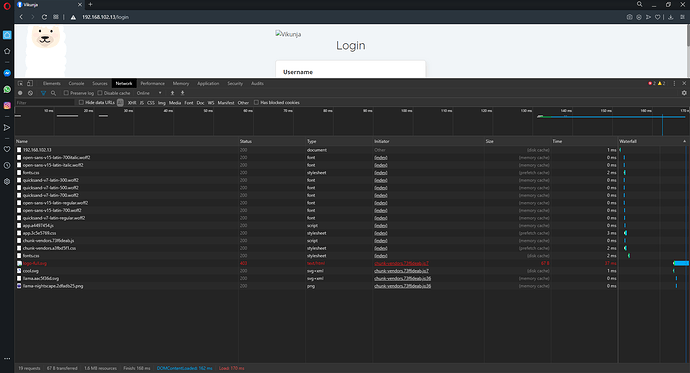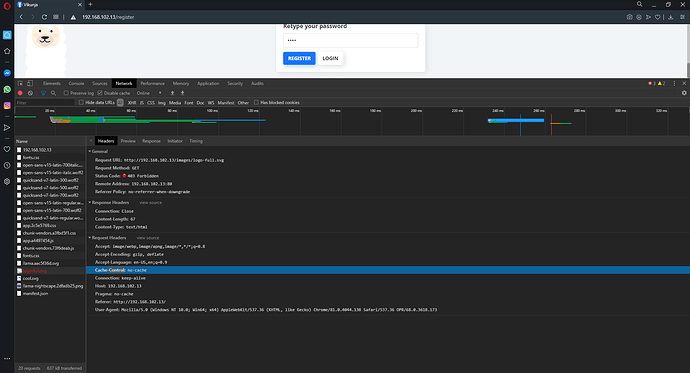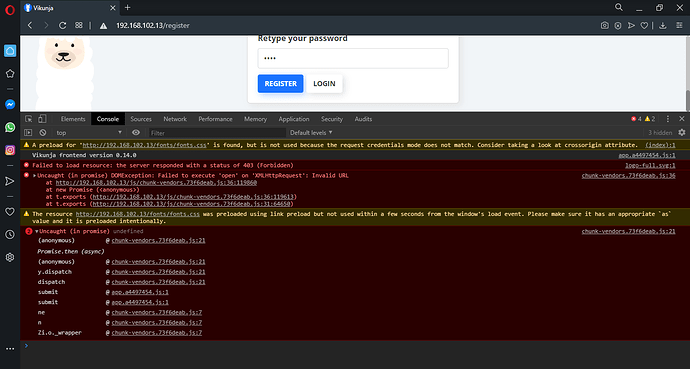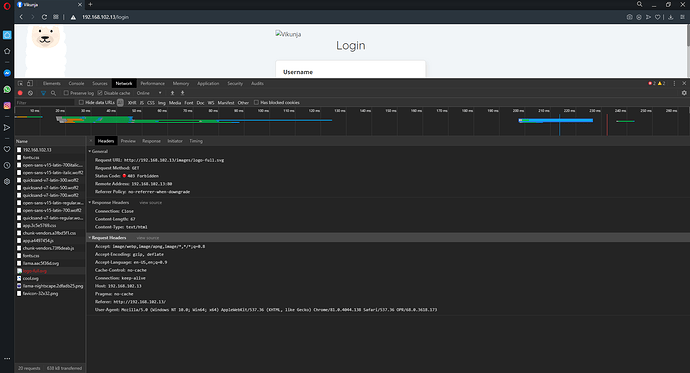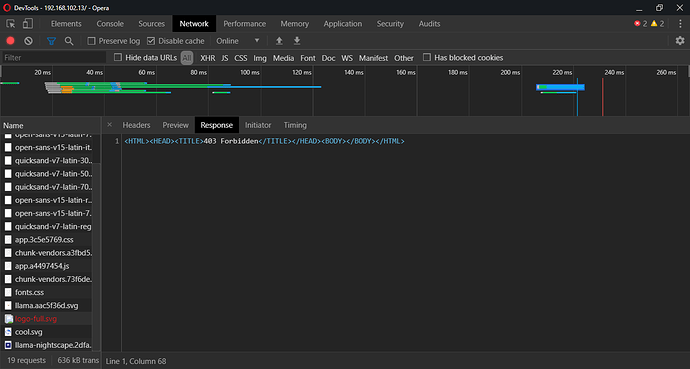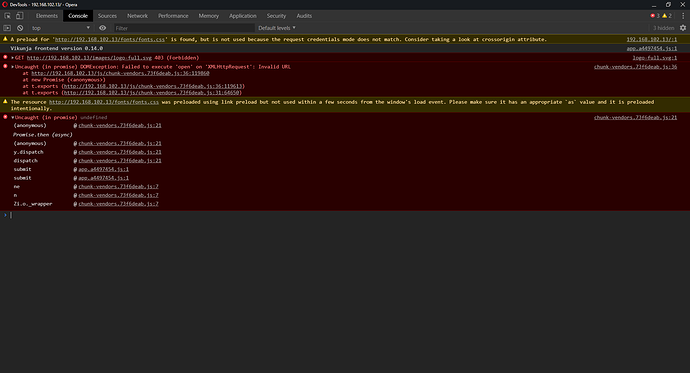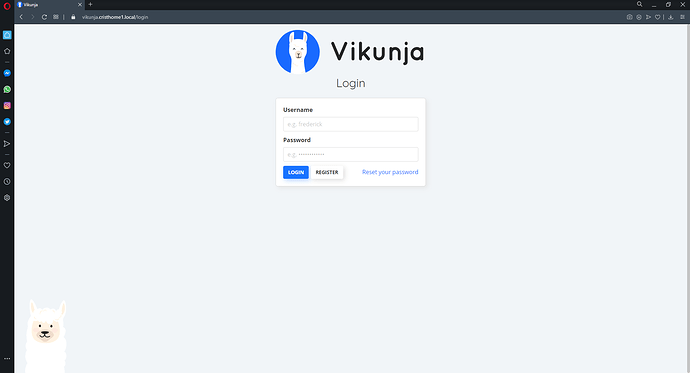Hey, loved the demo and figured I’d try to deploy Vikunja at home to help my family get a bit more organized.
I got the back and front ends installed, but I must’ve gotten wires crossed. I get the web interface but cannot register. Any idea where I might have gone wrong?
This is the console error report pulled from Opera.
Microsoft Edge gives a different set: (maybe the same causes?)
- Unhandled promise rejection Error: Network Error
- CONSOLE21301: serviceWorker.register is rejected due to unsecure context or host restriction in http://192.168.102.13/login.
- Error during service worker registration: SecurityError
Apache vikunja.config:
<VirtualHost :80>
ServerName vikunja
DocumentRoot /var/www/html
RewriteEngine On
RewriteRule ^/?(config.json|favicon.ico|css|fonts|images|img|js) - [L]
RewriteRule ^(.)$ /index.html [QSA,L]
Vikunja config
service:
$This token is used to verify issued JWT tokens.
$Default is a random token which will be generated at each startup of vikunja.
$ (This means all already issued tokens will be invalid once you restart vikunja)
JWTSecret: “”
$ The interface on which to run the webserver
interface: “:3456”
$ The URL of the frontend, used to send password reset emails.
frontendurl: “”
$ The base path on the file system where the binary and assets are.
$ Vikunja will also look in this path for a config file, so you could provide only this variable to point to a folder
$ with a config file which will then be used.
rootpath:
$ The max number of items which can be returned per page
maxitemsperpage: 50
$ If set to true, enables a /metrics endpoint for prometheus to collect metrics about the system
$ You’ll need to use redis for this in order to enable common metrics over multiple nodes
enablemetrics: false
$ Enable the caldav endpoint, see the docs for more details
enablecaldav: true
$ Set the motd message, available from the /info endpoint
motd: “”
$ Enable sharing of lists via a link
enablelinksharing: true
$ Whether to let new users registering themselves or not
enableregistration: true
$ Whether to enable task attachments or not
enabletaskattachments: true
$ The time zone all timestamps are in
timezone: GMT
$ Whether task comments should be enabled or not
enabletaskcomments: true
database:
$ Database type to use. Supported types are mysql, postgres and sqlite.
type: “sqlite”
$ Database user which is used to connect to the database.
user: “vikunja”
$ Databse password
password: “behrum2”
$ Databse host
host: “localhost”
$ Databse to use
database: “vikunja”
$ When using sqlite, this is the path where to store the data
Path: “./vikunja.db”
$ Sets the max open connections to the database. Only used when using mysql and postgres.
maxopenconnections: 100
$ Sets the maximum number of idle connections to the db.
maxidleconnections: 50
$ The maximum lifetime of a single db connection in miliseconds.
maxconnectionlifetime: 10000
$ Secure connection mode. Only used with postgres.
$ (see pq package - github.com/lib/pq - Go Packages)
sslmode: disable
cache:
$ If cache is enabled or not
enabled: false
$ Cache type. Possible values are memory or redis, you’ll need to enable redis below when using redis
type: memory
$ When using memory this defines the maximum size an element can take
maxelementsize: 1000
redis:
$ Whether to enable redis or not
enabled: false
$ The host of the redis server including its port.
host: ‘localhost:6379’
$ The password used to authenicate against the redis server
password: ‘’
$ 0 means default database
db: 0
cors:
$ Whether to enable or disable cors headers.
enable: true
$ A list of origins which may access the api.
origins:
- localhost:80
- localhost:3456
- 192.168.102.13:80
- 192.168.102.13:3456
$ How long (in seconds) the results of a preflight request can be cached.
maxage: 0
mailer:
$ Whether to enable the mailer or not. If it is disabled, all users are enabled right away and password reset is not possible.
enabled: false
$ SMTP Host
host: “”
$ SMTP Host port
port: 587
$ SMTP username
username: “user”
$ SMTP password
password: “”
$ Wether to skip verification of the tls certificate on the server
skiptlsverify: false
$ The default from address when sending emails
fromemail: “mail@vikunja”
$ The length of the mail queue.
queuelength: 100
$ The timeout in seconds after which the current open connection to the mailserver will be closed.
gueuetimeout: 30
log:
$ A folder where all the logfiles should go.
path: logs
$ Whether to show any logging at all or none
enabled: true
$ Where the error log should go. Possible values are stdout, stderr, file or off to disable error logging.
errors: “stdout”
$ Where the normal log should go. Possible values are stdout, stderr, file or off to disable standard logging.
standard: “stdout”
$ Whether or not to log database queries. Useful for debugging. Possible values are stdout, stderr, file or off to disable database logging.
database: “off”
$ Whether to log http requests or not. Possible values are stdout, stderr, file or off to disable http logging.
http: “stdout”
$ Echo has its own logging which usually is unnessecary, which is why it is disabled by default. Possible values are stdout, stderr, file or off to disable standard logging.
echo: “off”
ratelimit:
$ whether or not to enable the rate limit
enabled: false
$ The kind on which rates are based. Can be either “user” for a rate limit per user or “ip” for an ip-based rate limit.
kind: user
$ The time period in seconds for the limit
period: 60
$ The max number of requests a user is allowed to do in the configured time period
limit: 100
$ The store where the limit counter for each user is stored. Possible values are “memory” or “redis”
store: memory
files:
$ The path where files are stored
basepath: ./files # relative to the binary
$ The maximum size of a file, as a human-readable string.
$ Warning: The max size is limited 2^64-1 bytes due to the underlying datatype
maxsize: 20MB
migration:
$ These are the settings for the wunderlist migrator
wunderlist:
$ Wheter to enable the wunderlist migrator or not
enable: false
$ The client id, required for making requests to the wunderlist api
$ You need to register your vikunja instance at https://developer.wunderlist.com/apps/new to get this
clientid:
$ The client secret, also required for making requests to the wunderlist api
clientsecret:
$ The url where clients are redirected after they authorized Vikunja to access their wunderlist stuff.
$ This needs to match the url you entered when registering your Vikunja instance at wunderlist.
$ This is usually the frontend url where the frontend then makes a request to /migration/wunderlist/migrate
$ with the code obtained from the wunderlist api.
$ Note that the vikunja frontend expects this to be /migrate/wunderlist
redirecturl:

